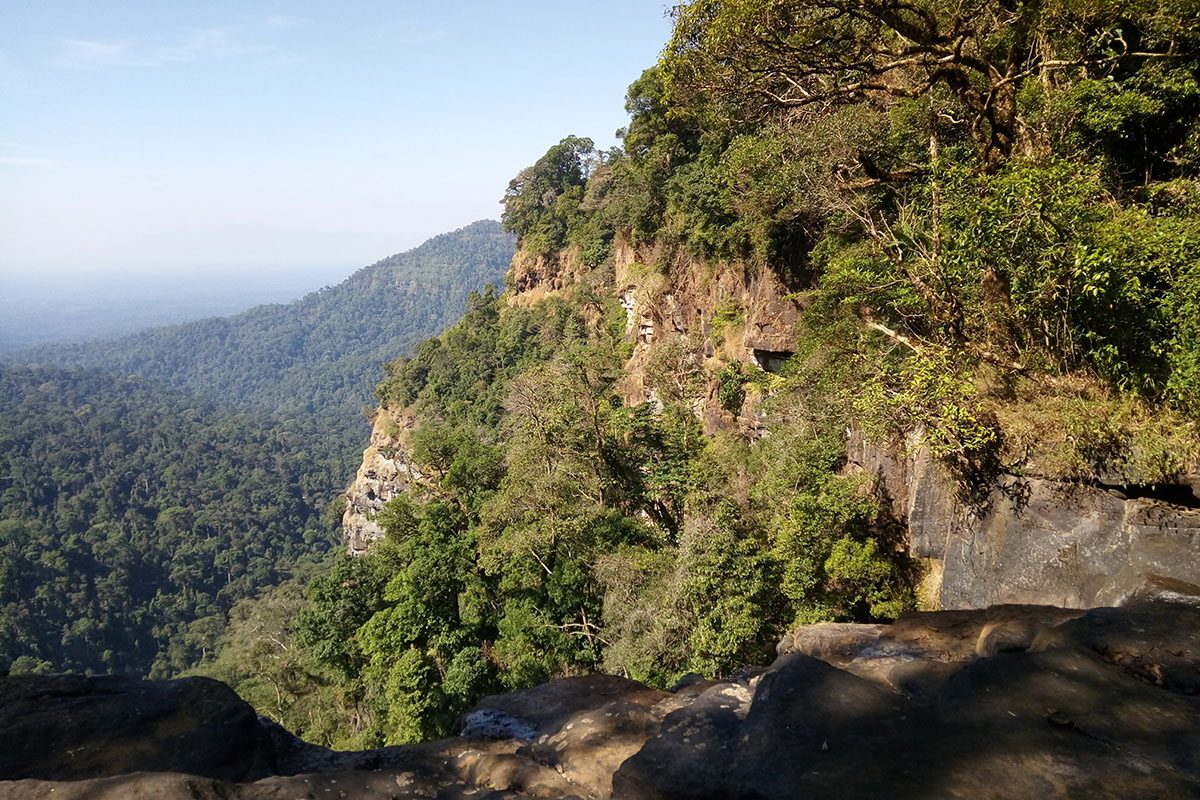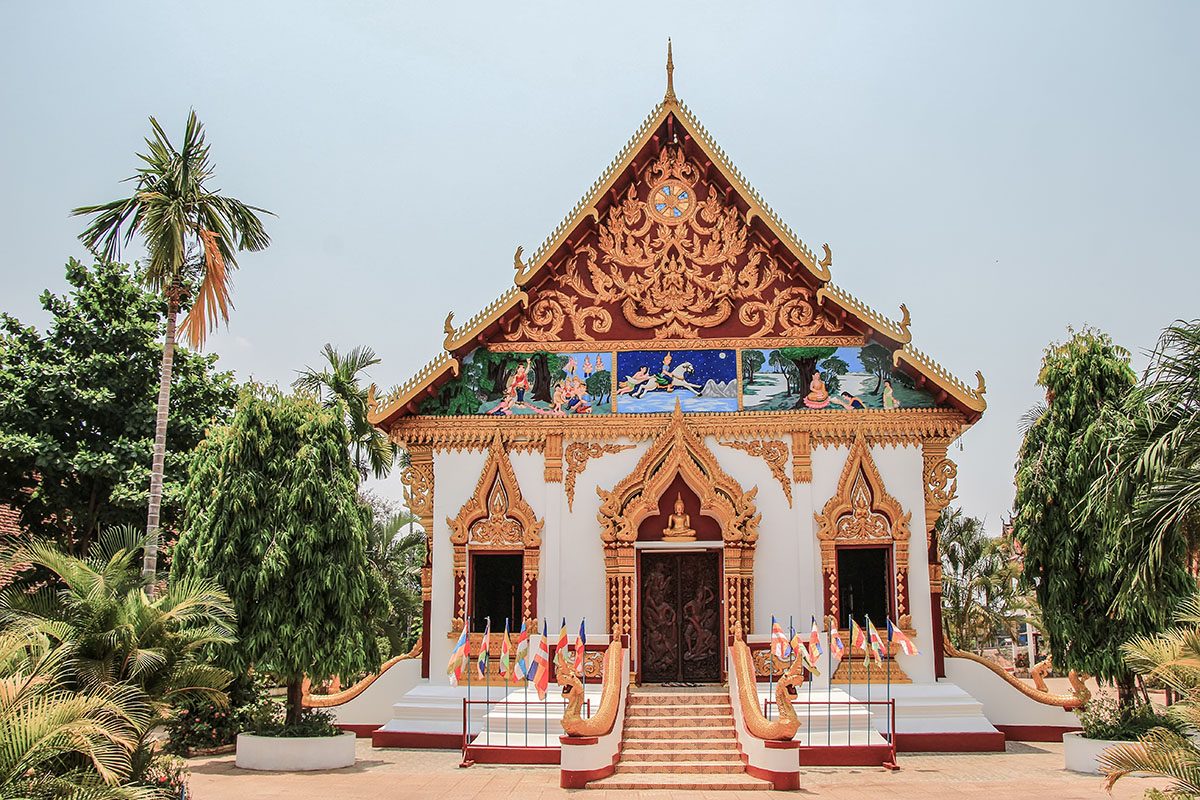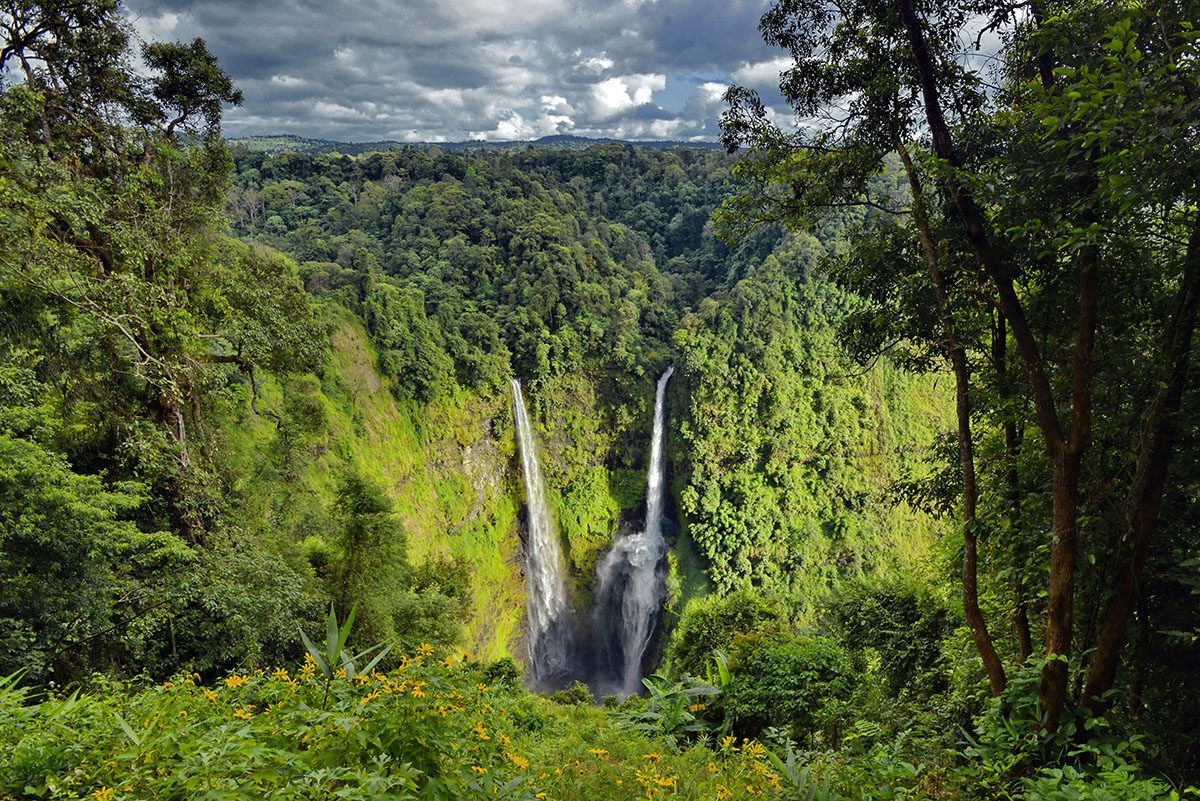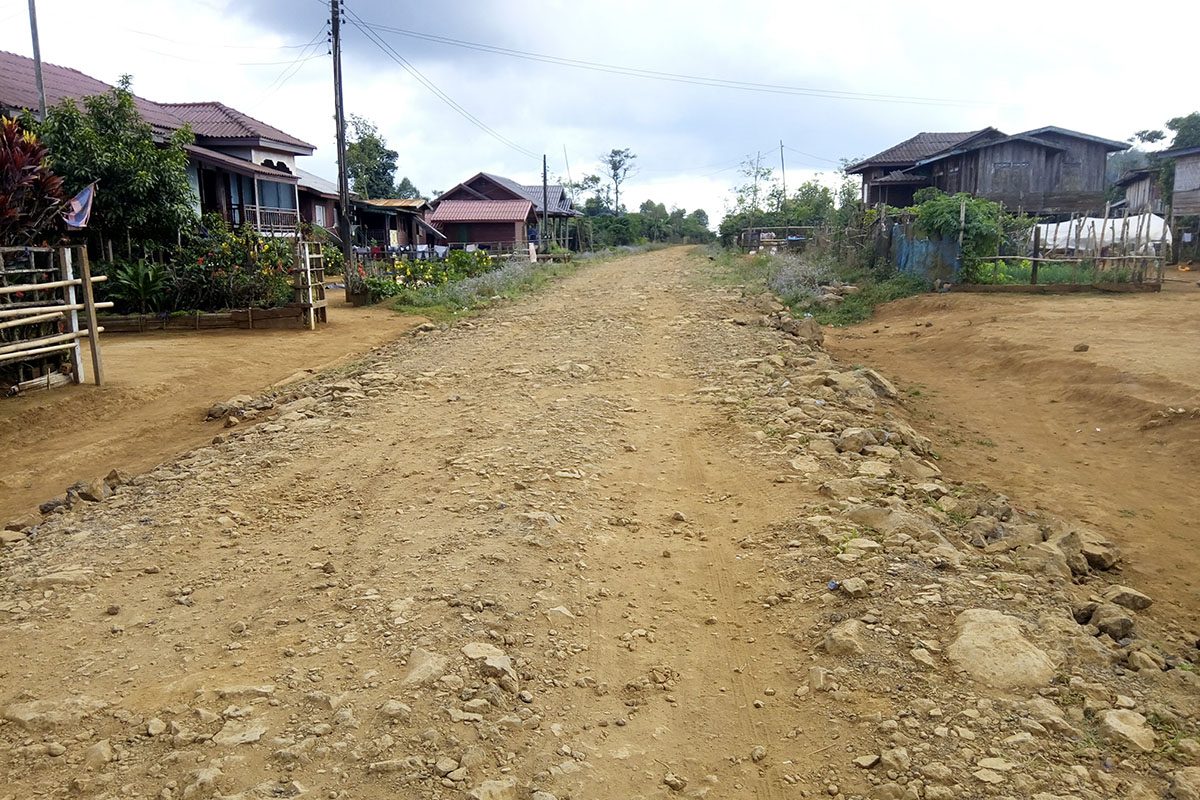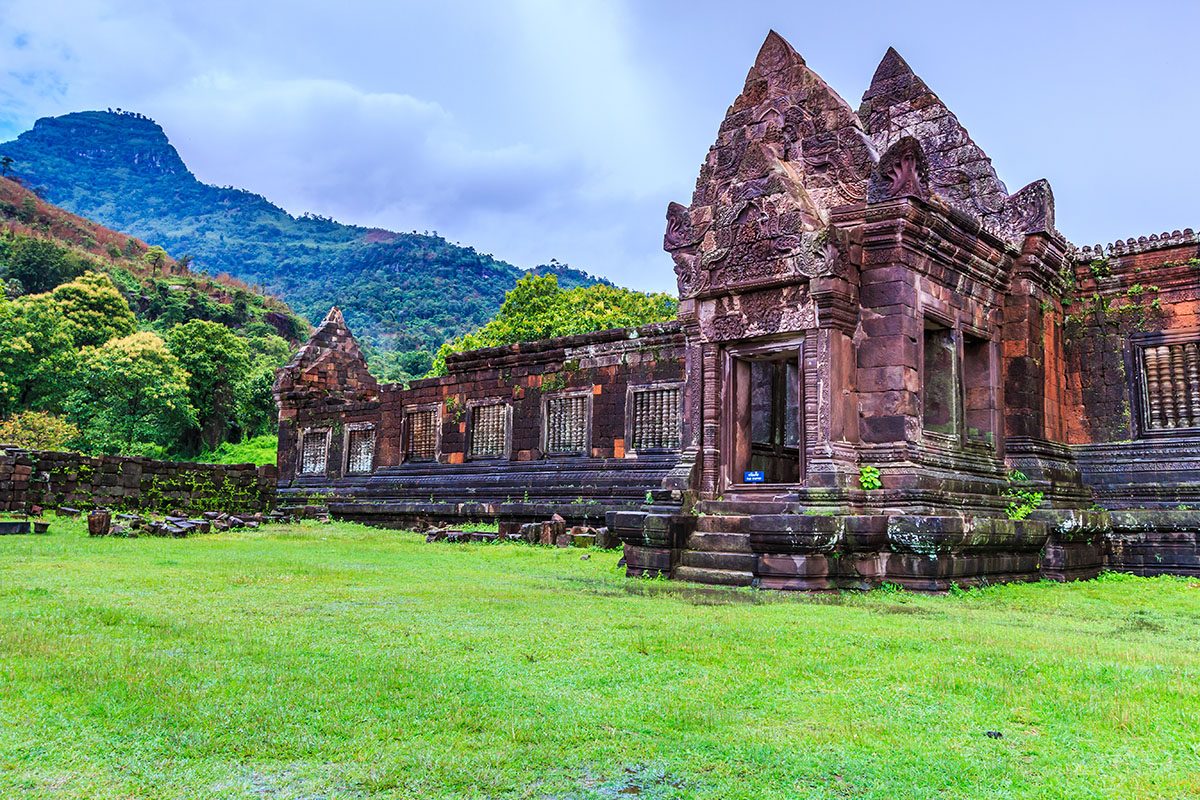Laos’ southern city, Pakse, isn’t famous for much. It’s widely known as a destination where ‘there isn’t much to do’. But the area is well worth a stay in – in fact, on my Laos itinerary, I advise travelers to spend the most time in this area.
Why is that? Two words: Bolevan Plateau. This area is unique in Laos, and absolutely bursting with natural beauty and native history. It’s well worth the visit to get to know this country on another level.
Oh, and I’ve got another word for you: Champasak. This is a town slightly south of Pakse, with fewer hotels and amenities. But it’s got some ancient ruins that could rival Angkor Wat, Mekong views and a laidback culture.
So lets dig into the best things to do in Pakse and around the city.
Best Things to do in Pakse
The Big Buddha
Big Buddhas are everywhere in Laos. It’s an incredibly religious country, and they punctuate the horizon near lots of main towns – and in some seemingly random places. Pakse has one of the best Big Buddhas in the country.
Looking over the river, the golden deity is best visited at sunset. It’s a tough climb up, but you’ll be able to see the city, the Mekong and the beautiful surrounding countryside – maybe even seeing up to the Boleavan Plateau.
You can drive a bike to the Buddha, or get a tuk tuk to take you – a return journey will cost about 40,000 kip.
Wat Luang
Considered the prettiest temple in the city, Wat Luang is also a visitor’s favourite. Sitting alongside the river, it is home to monks who still frequent the temple today – it originally started life as a monastic school. It’s a great spot to enjoy some traditional Lao architecture; be sure to admire the stupas and intricately carved wood panels.
Champasak Provincial Heritage Museum
This museum is a great spot to learn about the history and heritage of Champasak. It focuses mainly on ancient Khmer history, with lots of artefacts that were found in the area. There’s also a sombre reminder of Laos’ darker recent history, with actual UXO fragments that were dropped in the province. It’s definitely worth checking out to get another feel of Lao culture.
Get a Lao Massage
This is something that you can do in any Lao city, but it certainly is one of the most appealing things to do in Pakse when you’ve just finished trekking in the Bolevan Plateau! (More on that to come…). Lao massages are quite similar to their Thai cousins, so be prepared to be yanked around a bit and put into positions that you didn’t know possible. But, rest assured that you’ll feel great afterwards!
Where to Eat in Pakse
If you’re in Pakse for a few days, you’ll probably eat at all of the restaurants. There aren’t all that many. But my favourites were:
- Jasmin Indian Restaurant serving up bowls of goodness for 10,000 kip a pop, you can enjoy a channa masala or aloo gobi (and so much more) along with roti, rice or naan bread.
- Dok Mai Lao Italian Restaurant I wouldn’t normally recommend a western restaurant in Laos, but OMG this pasta was incredible. It’s probably the priciest restaurant in the city (about 60,000 kip for a pasta dish) but it was so worth it.
- DaoLin Restaurant this restaurant serves both traditional Lao food and western dishes. The spicy noodles I had were pretty good, as was the fruit shake. The WiFi is better here than anywhere else in Pakse, and they don’t mind you chilling and using it as long as it’s not busy.
There is one fully vegetarian restaurant in Pakse – but after reading less than complimentary reviews on HappyCow, I decided to avoid it. If you end up checking it out, leave me a comment and let me know how it is!
Where to Stay in Pakse
Hostel: Chato Hostel is one of my favourite hostels in South East Asia. It’s got spacious dorms with super comfy and sturdy beds, really thick bunk curtains that actually don’t let in light, individual bunk lights and some have en-suite bathrooms with hot water – otherwise, there are toilets and showers with hot water on every floor.
The staff are really friendly and helpful, especially the main man at reception who helped me with a lot of things. There’s a small kitchen area with a kettle and microwave that guests can use. WiFi is decent and they serve drinks and food at certain times of day.
It’s a very chill, quiet hostel (which is my fave – I love places where I can go to bed at 10pm) – but Pakse isn’t a party place at all, so nowhere is all that busy.
Click here to book Chato Hostel
Mid-Range Hotel: Intouch Riverside Hotel is a great place to stay if you want a slice of luxury without breaking the bank. The rooms are spacious and have en-suite bathrooms with separate showers. Rooms are clean and there is an open-air swimming pool. Click here to make a reservation.
Luxury Hotel: Le Jardin Hotel is perfect for those who want to live in luxury while in Pakse. Decorated with classy red wallpaper and furnishings, and offering a swimming pool and breakfast facilities, this hotel has everything you coul d want in upmarket accommodation. Click here for rates and to book.
Things to do Around Pakse
The Boleavan Plateau
The Boleavan Plateau is Pakse’s – and Champasak province’s – piece de resistance. It’s a breathtaking area filled with more waterfalls than you could shake a stick at, brimming with native culture and offering the country’s very best coffee. You literally could not want any more.
There are two ways to visit the Bolevan Plateau (actually, three – I saw a group of tourists seeing the main sites via tuk-tuk, but I have no idea how the vehicle made it up there!). The best ways are motorbike and a guided tour.
Motorbike is the most popular, but obviously this is only advisable if you can actually ride a motorbike (not me). Due to my inability both to ride a scooter and to find a friend who rides a scooter, I didn’t partake in this, but I did head down to Miss Noy’s Bike Shop and sit in on one of their information talks, just to get information for any of you wanting to motorbike on the Bolevan Plateau. I’m nice like that ;).
The talk at Miss Noy’s detailed how there are two loops, one big and one small. It’s recommended to spend 2-3 days on the small loop and 4-5 on the big loop. Basically, try and give the area as much time as possible.
If you hire a scooter from Miss Noy’s, the owner will give you a full debrief of the area, things to do, places to go and safety tips for the bike. It’s well worth using their bike shop for this reason. The owner is Belgian and speaks English and French. You can also book bus tickets from here!
If you can’t or don’t want to ride a bike, don’t worry – bikes are sexy, but so is street safety. I’m not saying I’d never drive a bike in South East Asia, but driving around the bumpy roads of the Boleavan Plateau was not going to be my first time!
If you opt to not ride a bike, there are a few tour options. This tour on Viator includes trekking around the nature of the area, staying in a traditional homestay, seeing various waterfalls, and eating authentic Lao food. It’s a really good way to see the spectacular Bolevan Plateau without hanging on, terrified, on the back of a scooter.
Note: If you do go trekking independently in the Bolevan Plateau, seek out local advice before and stay on the path. There are still lots of UXOs (unexploded ordnance) in Laos from the Vietnam War, and they do still explode. Guided tours obviously know where is safe to go, so if you’re unguided make sure you do your research.
Things to Do in Champasak
Champasak is located about an hour’s drive from Pakse. It’s possible to visit the town on a day trip from Pakse, or stay overnight here if you wish.
Wat Phu
Wat Phu is a temple complex near Champasak, which is about 40 minutes south of Pakse. To get there, either hop on yer motorbike or, (if you’re like me), take a tuk tuk (which should cost abotu 100,000 kip) or join a guided tour.
Wat Phu has some similarities to Angkor Wat, and is a lot smaller – but is also cheaper and about a million times quieter, so it’s still worth checking it out even if you’ve already visited its Cambodian cousin.
Wat Muang Kang
This is Champasak’s oldest active temple and has a unique mix of architectural styles. Some of its structure is slightly crumbling, which only adds to its charm, and it is commonly frequented by monks. Even if you’ve seen a lot of temples by this point, its mystique and rural setting make it one that you should add to your list!
Ban Nong Bueng woodcarving village
This village is famous for… you guessed it, wood carvings. The Lao and Taoy minority groups create all sorts of trinkets and carvings, some which demonstrate Lao life and some which just seem completely absurd! You can also purchase wooden carvings here, which directly helps the villagers.
Don Daeng Island
This authentic island is world’s away from Don Det in the south – although in reality, it’s just up the Mekong. It’s part of the UNESCO World Heritage “cultural landscape” of Champasak.
The edges of the island are host temples and small villages, with rice paddies in the middle, where the majority of the island-dwellers work. The best way to see Don Daeng is by bicycle or just walking around on foot, taking in the rural atmosphere.
There are also homestays in Ban Hua Village; these can be organised with the tourist office in Champasak. Another option, if you would like to stay on the island, is La Folie Lodge – click here for more information.
Wat Um Tomo
Considerably smaller than Wat Phu is Wat Um Tomo, which is largely just a rubble of ruins along a walkway. It is, however, close to Don Daeng and is a really tranquil spot in the river, so is worth checking out while you’re in the area.
Where to Stay in Champasak
Guesthouse: Kamphouy Guesthouse is a quiet, clean and comfortable guesthouse, with an owner who speaks great English and is very helpful about travel around Laos. It is located right next to the bus stop andhas good WiFi. Rooms are basic but adequate for a value stay. Click here for rates and to book.
Hotel: Nakorn Riverview has a classy eastern feel, with ornate archtiecture and beautiful decor. It overlooks the beautiful river and has an on-site bar. Rooms enjoy an en-suite with separate shower and comfy beds. Click here for rates and to book.
If you’re travelling in Laos, make sure you check out these blog posts!
- Your Ultimate Laos Itinerary
- Things to do in Savannakhet
- Things You Should Know Before Backpacking Laos
- How Not to go Hiking in Vang Vieng
- Is Kong Lor Cave Worth It?
- How to See the Thakhek Loop with no Motorbike
And if you’re heading over to Vietnam next, make sure you check out my absolutely huge (and bursting with information) Vietnam itinerary.
Going to Thailand? Here is my Thailand itinerary, or catch how to spend three days in Bangkok here.
If you’ve enjoyed this post, please share it and follow me on Facebook, Instagram and Youtube

